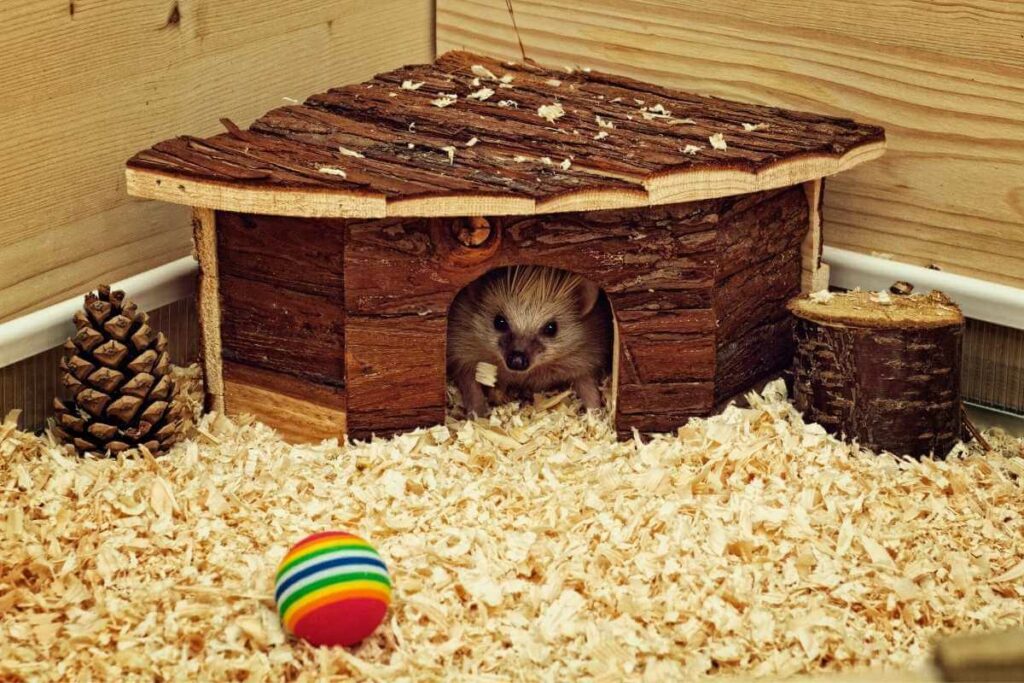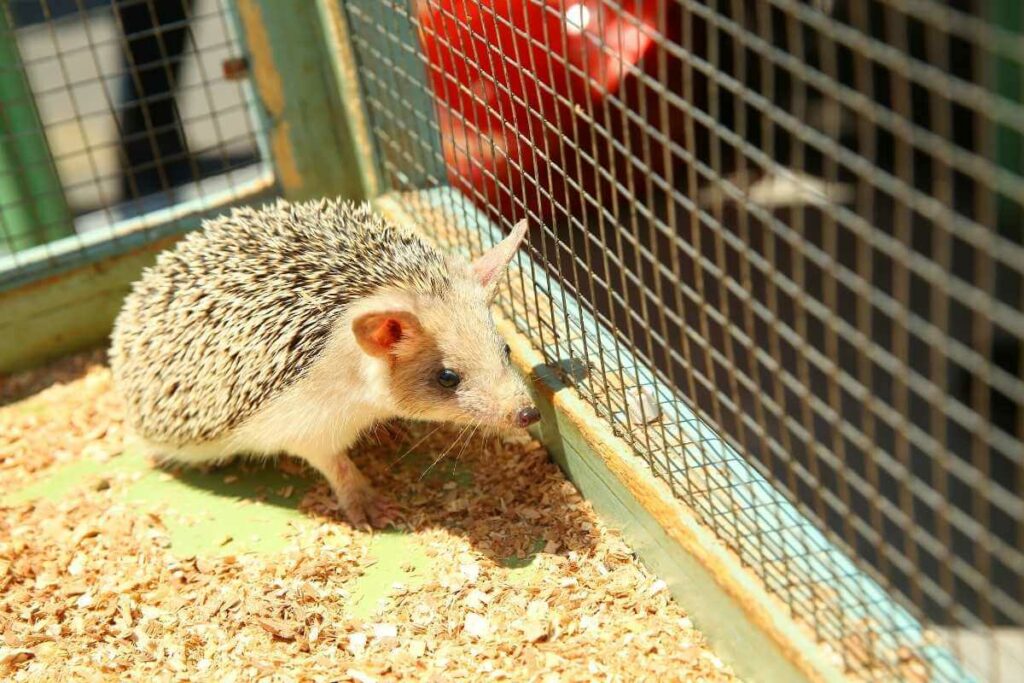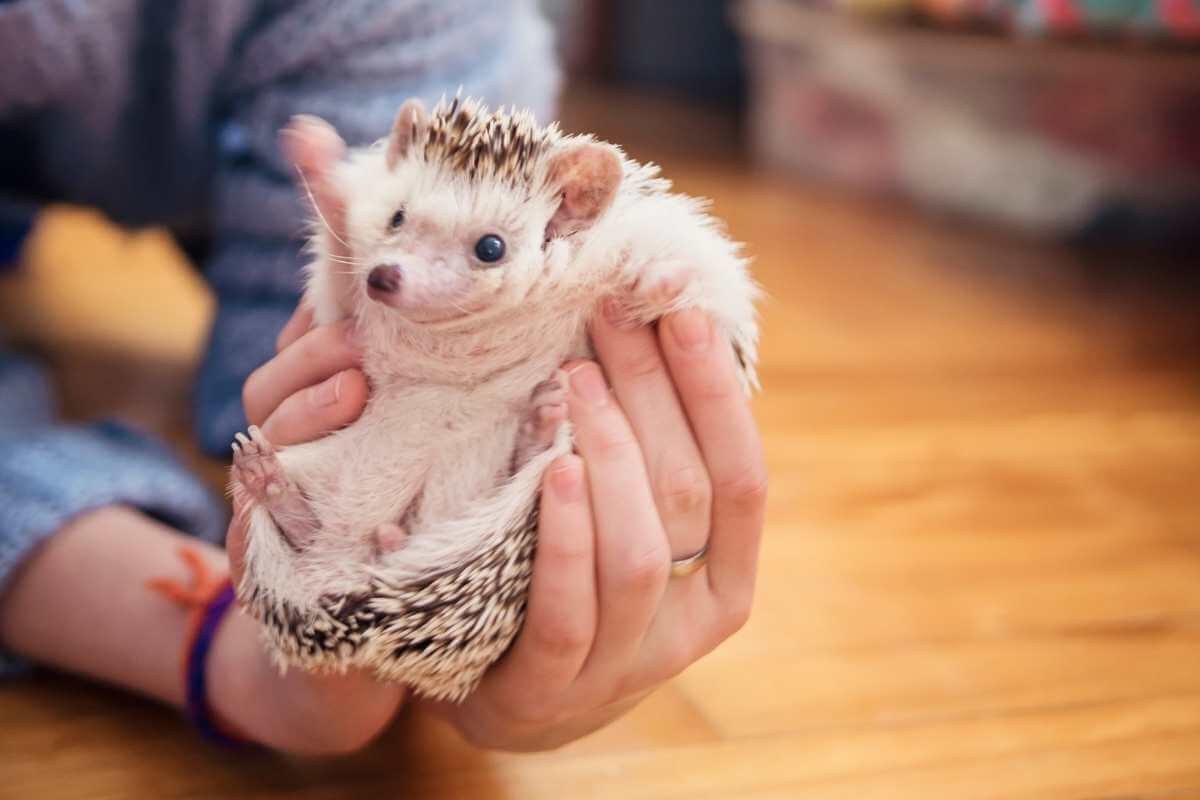Hedgehogs are amazing, gentle creatures with an intelligent, and charismatic nature.
They are wild creatures and should only be kept if they have been found injured or abandoned.
Owners who want to keep household pests away through natural means often choose hedgehogs as a more humane alternative to toxic chemicals.
However, much more than just food and water goes into setting up your new pet’s home.
In This Article: we’ll show you a complete guide to setting up your hedgehog bedding to ensure your furry friend loves their tiny hedgehog house!
What Is a Hedgehog and Where Do They Live?
Hedgehogs are small-to-medium-sized mammals native to Europe, Asia, and Africa.
Their name is derived from the quills or spines that cover their entire body along with a pointy snout.

If you’re thinking of adopting your pet hedgehog, you probably want to know how best to care for them.
Important Hedgehog Facts to Know
When it comes to having a hedgehog as a pet, it is essential to grasp these critical facts:
- They are nocturnal by nature, so expect to see them most active at night. They sleep during the day and come out foraging for insects at dusk or dawn in the wild. If you want to interact with your pet in any meaningful way, you will need to learn their sleeping patterns.
- They are not related to porcupines, but the quills they use for self-defense function similarly. If threatened, your pet can raise its spines and point them in any direction it pleases. Their sharp quills may break off into skin or mouth if mishandled, so exercise caution when holding or playing with your new pet.
- Hedgehogs are solitary creatures by nature, so they live alone in the wild and will be happiest in captivity. However, if you want to provide companionship for your pet hedgehog, you can buy them a suitable playmate from an exotic animal store.
- Their diet consists of insects such as mealworms or crickets and earthworms, along with fruits and vegetables. Their diet should be supplemented with high-quality hedgehog food to ensure that they get all the nutrients they need for a healthy life.
Hedgehog Housing
Now that you know everything that you need to about caring for a pet hedgehog, let’s look at how they can fit into your home!
Of course, suitable housing is essential to a hedgehog’s survival.
The most suitable homes for a hedgehog are wire dog cages or aquariums. However, you can also use larger glass enclosures, as long as the enclosure is appropriately ventilated and easy to clean.
Make sure your pet can enter and exit quickly, with enough space to stand up on their back legs without bumping their heads.
One important thing to remember is that hedgehogs are nocturnal, which means they like sleeping during the day and staying active at night.
As such, it’s best if you use an enclosure with a solid top, so your pet doesn’t get cold overnight.
When choosing housing for your hedgehog, there are several guidelines to keep in mind:
- They do not get along well with others, so you should plan for your pet to live alone. Offer companionship if you must, but make sure that they have their own housing.
- Your hedgehog should be able to enter and exit its home without touching the sides or top. Taller is better, as hedgehogs are great climbers by nature.
- Clear all obstacles from around your pet’s sleeping area so it can be safe and secure in its own place.
- Place the house somewhere quiet, with minimal disturbance from people and pets. Keep it out of high traffic areas such as hallways and doorways where your pet may get accidentally kicked or stepped on by mistake. This also means that you should not keep their house too close to loud areas like washing machines or furnaces.
- Their home should be dark, so avoid placing it in direct sunlight if possible. If you must put their house somewhere sunny, at least provide them with a zen den or small box to take shelter in when they want to rest.
- Placing food and water near your pet’s sleeping area is crucial for keeping the enclosure clean and odor-free.
Hedgehog Bedding and Litter Boxes
We already mentioned that hedgehogs are solitary creatures, but this information is especially important when it comes to their living space.
For your pet’s sake, you’ll want to provide plenty of hiding places for them to curl up into or escape from others if needed.

Providing this kind of security is as easy as filling your pet’s home with bedding appropriate for their size.
Hedgehogs are small creatures, but they still need a suitable place to sleep inside their home.
Their beds should be at least six inches deep and made out of non-toxic material such as shredded paper or wood chips.
You will also need to provide an additional bedding area for your pet’s litter box.
From Experience: We recommend using recycled paper bedding, such as brands including Carefresh. This material is soft and absorbent, which means that it will soak up waste without leaving a strong smell.
Cleaning up After Your Hedgehog
Your hedgehogs will need a clean and healthy home to live in. To keep their living space as spotless as possible, you should provide them with cleaning supplies and regularly remove and replace things such as bedding and litter boxes.
When removing waste from your hedgehog’s house, be sure to use disposable gloves for their protection.
You never want to risk getting any of that nasty waste on your own skin under any circumstance.
When it comes to replacing bedding material, you should be ready to replace it at least once every week.
After all, hedgehogs make a big mess with their bedding and litter boxes no matter how often you clean!
Replacing litter box material is more complicated.
You should provide your pet with a new litter box for every day they that use the old one, which means that you will need to be prepared to clean out their litter boxes at least once a day.
Hedgehog Care and Feeding
The process of feeding and cleaning up after your hedgehog is going to take a lot of time and energy.
If you don’t want to spend a lot of time and money on your pet’s care, you should consider getting two instead.
Keeping more than one hedgehog increases their socialization and makes it easier for you to maintain a clean living space.
It is very important that we stress the importance of feeding your hedgehog the right kinds of food.
This means that if your hedgehog is an adult, you should only feed them food designed for the health and wellness of hedgehogs in particular.
However, if your hedgehog is still a baby (under six months old), you will need to switch them over to kitten food as they wean off their mother’s milk.
Kitten food is made of finer ingredients and is easier for their immature digestive systems to handle.
One thing that your hedgehog will need in order to survive is a source of fresh water.
You can provide them with a water dish, but some experts recommend adding a drip system so you don’t have to worry about tipping it over or cleaning it out as often.
Hedgehog-Proofing Your Home
Hedgehogs are big fans of climbing and playing with sticks, so it is important that they live in a home where there aren’t any hazards for falling or anything else they might get hurt on.
To hedgehog-proof your home, you will need to remove things such as strings, loose wires, and other things that they might get caught up in.
You will also need to keep your pet’s living space away from any source of heat, such as a fireplace or radiator.
Pet Hedgehogs and Other Pets
Hedgehogs are far more likely to bite than other pets such as rabbits or hamsters, so it is important that you supervise how your hedgehog interacts with your other pets.
In particular, cats and dogs can pose a serious threat to small animals such as pet hedgehogs. Dogs are likely to play too rough, while cats might try to eat them!
Hedgehogs also have a bad habit of going missing when left alone in a room with another pet.
If you notice that your hedgehog is missing, try looking for them in closets or other hiding places that might attract them.
Tips for a Happy and Healthy Hedgehog
To help your furry friend enjoy a happy and healthy life, you need to provide them with a clean living space, nutritious food, and lots of love.
It is important that we stress the importance of providing your hedgehog with a stimulating living environment.
Hedgehogs like climbing and playing with toys (especially sticks), so it is recommended that they be provided with things such as large paper bags, tubes, and boxes.
Make Your House a Home for Your Hedgehog Today!
Hedgehogs are also very social animals who enjoy playing with their humans.
To make your hedgehog feel more comfortable in their new home, you should introduce them to other hedgehogs or pets from a young age.
You can also try introducing them to the outside world when they get older!
Final Thougths
With this guide, you should now be able to provide your pet hedgehog with everything they need in order to thrive.
If you follow this guide closely, you should be well on your way to a happy and healthy life for your new friend!
You May Also Like
- I Have a Hedgehog in My Garden, What Do I Do?
- Do Skinks Make Noise?
- Is It Safe to Feed a Chipmunk By Hand?
